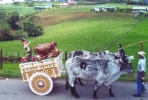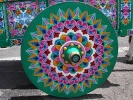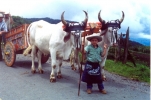Print
IDENTIFICATION | IDENTIFICACIÓN | IDENTIFICAÇÃO
Tangible or Intangible
Intantigle | Inmaterial | Imaterial
Image credits | Créditos de imagen | Créditos de imagem
Carmen Murillo / Ministerio de Cultura, Juventud y Deportes
Title, name | Titulo, nombre | Título, nome
Oxherding and Oxcart Traditions in Costa Rica / La tradición del boyeo y las carretas
Short description | Descripción corta | Descrição resumida
The traditional oxcart, or carreta, is the product of Costa Rica’s most famous craft. Each oxcart is designed to make its own ’song’, a unique chime produced by a metal ring striking the hubnut of the wheel as the cart bumped along. While in most regions of Costa Rica trucks and trains replaced oxcarts as the main means of transport, the carretas remain strong symbols of Costa Rica’s rural past, and still feature prominently in parades and in religious and secular celebrations. Since oxcarts have become obsolete as means of transport, there is a decreasing demand for them, which means that the number of artisans who possess the training to manufacture and decorate oxcarts has strongly declined over the past decades.
La tradicional carreta de bueyes es el tipo de artesanía más famoso de Costa Rica. Cada carreta de bueyes se fabrica para producir su propio “canto”, un carillón único producido por un anillo del metal que golpea el cubo de la rueda cuando la carreta traquetea por los caminos.
En la mayoría de las regiones de Costa Rica, los camiones y los trenes han substituido a las carretas como principal medio de transporte, pero éstas siguen siendo símbolos fuertes del pasado rural del país, y aún ocupan un lugar importante en los desfiles y las celebraciones religiosas y profanas. Al convertirse la mayoría de las carretas en un medio de transporte obsoleto, se ha reducido la demanda de carretas, y por tanto también ha disminuido en las últimas décadas el número de artesanos que dominan la técnica para fabricarlas y decorarlas.
La tradicional carreta de bueyes es el tipo de artesanía más famoso de Costa Rica. Cada carreta de bueyes se fabrica para producir su propio “canto”, un carillón único producido por un anillo del metal que golpea el cubo de la rueda cuando la carreta traquetea por los caminos.
En la mayoría de las regiones de Costa Rica, los camiones y los trenes han substituido a las carretas como principal medio de transporte, pero éstas siguen siendo símbolos fuertes del pasado rural del país, y aún ocupan un lugar importante en los desfiles y las celebraciones religiosas y profanas. Al convertirse la mayoría de las carretas en un medio de transporte obsoleto, se ha reducido la demanda de carretas, y por tanto también ha disminuido en las últimas décadas el número de artesanos que dominan la técnica para fabricarlas y decorarlas.
Community or culture | Comunidad o cultura | Comunidade ou cultura
Costa Rica
Practitioners, Autor | Practicantes, Autores | Praticantes, Autores
Costa Rica's traditional ox carts owners
Museum | Museo | Museu
Place | Local | Local
Country | País
Costa Rica
Language | Idioma
Español
MEDIA
Video | Vídeo
Video credits | Créditos de vídeo | Créditos vídeo
Ministerio de Cultura, Juventud y Deportes de Costa Rica / UNESCO
Audio
Audio Credits | Créditos de Audio
3D object | Objeto 3D
3D Credits | Créditos 3D
Text | Texto
Text credits | Créditos del texto | Créditos do texto
Record date | Fecha de registro | Data do registo
2009-09-28
Image 1 credits | Créditos imagen 1 | Créditos da imagem 1
Carmen Murillo / Ministerio de Cultura, Juventud y Deportes
Image 2 credits | Créditos imagen 2 | Créditos da imagem 2
Carmen Murillo / Ministerio de Cultura, Juventud y Deportes
Image 3 credits | | Créditos da imagem 3Créditos imagen 3
Carmen Murillo / Ministerio de Cultura, Juventud y Deportes
Image 4 credits | Créditos imagen 4 | Créditos da imagem 4
Carmen Murillo / Ministerio de Cultura, Juventud y Deportes
MORE INFORMATION | MÁS INFORMACIÓN | MAIS INFORMAÇÃO
Origin, history | Origen, historia | Origem, história
Dating from the mid-nineteenth century, oxcarts were used to transport coffee beans from Costa Rica’s central valley over the mountains to Puntarenas on the Pacific coast, a journey requiring ten to fifteen days. The oxcarts used spokeless wheels, a hybrid between the disc used by the Aztec and the spoked wheel introduced by the Spaniards, to cut through the mud without getting stuck. In many cases, oxcarts were a family’s only means of transport; they often served as a symbol of social status. The tradition of painting and decorating oxcarts started in the early twentieth century. Originally, each region of Costa Rica had its own particular design, enabling the identification of the driver’s origin by the painted patterns on the wheels. By the beginning of the twentieth century, flowers, faces and miniature landscapes began to appear beside patterns of pointed stars, and to this day annual contests reward the most creative artists in this tradition. Each oxcart is designed to make its own ’song’, a unique chime produced by a metal ring striking the hubnut of the wheel as the cart bumped along. Once the oxcart had become a source of individual pride, greater care was taken in their construction, and the highest-quality woods were selected to make the best sounds. Today’s colourful and richly decorated carretas bear little resemblance to the original rough-hewn, rectangular, caneframed vehicles covered by rawhide tarps. While in most regions of Costa Rica trucks and trains replaced oxcarts as the main means of transport, the carretas remain strong symbols of Costa Rica’s rural past, and still feature prominently in parades and in religious and secular celebrations. Since oxcarts have become obsolete as means of transport, there is a decreasing demand for them, which means that the number of artisans who possess the training to manufacture and decorate oxcarts has strongly declined over the past decades.
Desde mediados del siglo XIX, las carretas de bueyes eran utilizadas para transportar el grano de café desde el valle central de Costa Rica, en las montañas, a Puntarenas, en la costa del Pacífico. Un viaje requería de 10 a 15 días. Las carretas de bueyes tenían ruedas sin radios, un híbrido entre el disco usado por los aztecas y la rueda de radios introducida por los españoles, para avanzar en medio del fango sin atascarse. En muchos casos, las carretas de bueyes eran el único medio de transporte de una familia y simbolizaban su estatuto social. La tradición de pintar y engalanar las carretas comenzó a principios del siglo XX. Originalmente, cada región de Costa Rica tenía su propio diseño, lo que permitía identificar el origen del boyero por los motivos pintados en las ruedas. A principios del siglo XX, flores, rostros y paisajes en miniatura empezaron aparecer al lado de los motivos que representaban estrellas puntiagudas. Se organizaron concursos anuales para premiar a los artistas más creativos, costumbre que aún perdura hoy día. Cada carreta de bueyes se fabrica para producir su propio “canto”, un carillón único producido por un anillo del metal que golpea el cubo de la rueda cuando la carreta traquetea por los caminos. Cuando las carretas de bueyes se convirtieron en motivo de orgullo individual, se las construía con mayor cuidado, seleccionando las maderas de mejor calidad para producir los mejores sonidos. Las carretas variopintas y ricamente engalanadas de hoy se parecen poco a los vehículos originales rectangulares, con un cuadro de caña y toscamente labrados y cubiertos de cuero sin curtir. En la mayoría de las regiones de Costa Rica, los camiones y los trenes han substituido a las carretas como principal medio de transporte, pero éstas siguen siendo símbolos fuertes del pasado rural del país, y aún ocupan un lugar importante en los desfiles y las celebraciones religiosas y profanas. Al convertirse la mayoría de las carretas en un medio de transporte obsoleto, se ha reducido la demanda de carretas, y por tanto también ha disminuido en las últimas décadas el número de artesanos que dominan la técnica para fabricarlas y decorarlas.
Desde mediados del siglo XIX, las carretas de bueyes eran utilizadas para transportar el grano de café desde el valle central de Costa Rica, en las montañas, a Puntarenas, en la costa del Pacífico. Un viaje requería de 10 a 15 días. Las carretas de bueyes tenían ruedas sin radios, un híbrido entre el disco usado por los aztecas y la rueda de radios introducida por los españoles, para avanzar en medio del fango sin atascarse. En muchos casos, las carretas de bueyes eran el único medio de transporte de una familia y simbolizaban su estatuto social. La tradición de pintar y engalanar las carretas comenzó a principios del siglo XX. Originalmente, cada región de Costa Rica tenía su propio diseño, lo que permitía identificar el origen del boyero por los motivos pintados en las ruedas. A principios del siglo XX, flores, rostros y paisajes en miniatura empezaron aparecer al lado de los motivos que representaban estrellas puntiagudas. Se organizaron concursos anuales para premiar a los artistas más creativos, costumbre que aún perdura hoy día. Cada carreta de bueyes se fabrica para producir su propio “canto”, un carillón único producido por un anillo del metal que golpea el cubo de la rueda cuando la carreta traquetea por los caminos. Cuando las carretas de bueyes se convirtieron en motivo de orgullo individual, se las construía con mayor cuidado, seleccionando las maderas de mejor calidad para producir los mejores sonidos. Las carretas variopintas y ricamente engalanadas de hoy se parecen poco a los vehículos originales rectangulares, con un cuadro de caña y toscamente labrados y cubiertos de cuero sin curtir. En la mayoría de las regiones de Costa Rica, los camiones y los trenes han substituido a las carretas como principal medio de transporte, pero éstas siguen siendo símbolos fuertes del pasado rural del país, y aún ocupan un lugar importante en los desfiles y las celebraciones religiosas y profanas. Al convertirse la mayoría de las carretas en un medio de transporte obsoleto, se ha reducido la demanda de carretas, y por tanto también ha disminuido en las últimas décadas el número de artesanos que dominan la técnica para fabricarlas y decorarlas.
Associated heritage | Patrimonio asociado | Património associado
Cross reference | Referencias cruzadas | Referências cruzadas
Present condition | Condición actual | Estado actual
Threats | Amenazas | Ameaças
Safeguard | Salguardia | Salvaguarda
Bibliography | Bibliografía | Bibliografia
Source | Fuente | Fonte
TANGIBLE | MATERIAL
Type of object | Tipo de objeto | Tipo de objecto
Domain | Dominio | Domínio
Please select
Category | Categorías | Categoria
Please select | Seleccionar
Materials & techniques | Materiales y técnicas | Materiais & Tecnicas
Measurements | Medidas
Aditional info | Información adicional | Informação adicional
INTANGIBLE | INMATERIAL | IMATERIAL
Domain | Dominio | Dominío
Traditional craftsmanship | Artesanía tradicional | Saber fazer
Category | Categoria
Manufacturing activities | Actividades de fabricación | Actividades Transformadoras, Transport, trade and communication | Transporte, comercio y comunicación | Transportes comércio e comunicação, Cyclical festivities | Fiestas cíclicas | Festividades cíclicas
Periodicity | Periodicidad | Periodicidade
Transmission | Trasmisión | Transmissão







